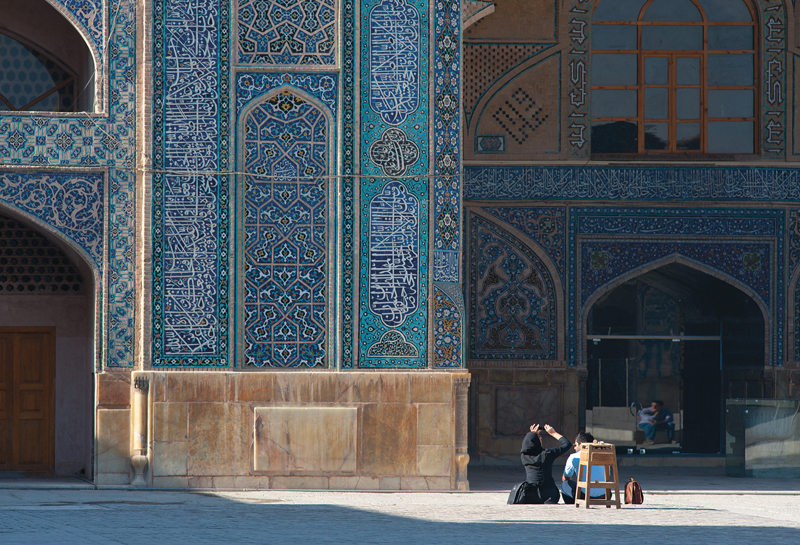
Persian foodways have had a huge impact on the rest of the world. The legacy of the Persian Empire includes apricots and bitter oranges, underground waterways and irrigation, ice cream, the pulao family of rice dishes, and the use of tart fruits in savory dishes. And winemaking seems to have originated about eight thousand years ago in what is present-day Georgia or Armenia, or perhaps simultaneously in a number of places in the Caucasus.
The mosaic of people in the region reflects history, geography, and culture. When Persian rulers conquered neighboring lands, they brought Persian culture with them, but they also learned from the conquered. They forcibly moved neighboring populations (Georgians, Armenians, Azeris, and others) into Persia. Over the centuries, borders have been redrawn many times, right up to the present day.
Consequently, the current borders of Iran, Kurdistan, and the Caucasus countries enclose many different peoples in a kind of dizzying, overlapping patchwork. In Iran, there are Armenians, people of Georgian ancestry, Kurds, Azeris, and Assyrians, among others. Until the breakup of the USSR in the early 1990s, there were large communities of Armenians in Azerbaijan and of Azeris in Armenia. Georgia was long home to many Armenians, and it still has large Azeri and Armenian populations. Kurdistan’s population includes not only Kurds, who are the majority, but also many Assyrians and Yazidis. And there are Kurds and Yazidis living in Georgia and Armenia.
How do people in the region define themselves? They most often identify first as citizens of a particular country (though they may instead start with their native language or ethnicity). Then they mention language and religion. Even when kingdoms and conquerors have vanished into the mists of time, traces of their cultures often remain. Nothing is “pure”—no people or country in the region can claim to be the one origin of a dish or a technique. Too much has happened over the centuries, in the way of mixing cultures and peoples, for any such claim to have credibility.
I’m mentioning this because people in the region have a fierce sense of national pride. In the food sphere, this often translates into “gastro-nationalism”—assertions that “we” invented the dish that you claim is yours. But the fact that I came upon a particular dish in Armenia or Iran, Georgia, or Azerbaijan does not mean that the dish belongs to the people of that nation, or that its roots lie solely there.
Shared elements in the region’s culinary cultures include walnuts, pomegranates, and other tart fruits, all used in many savory dishes as flavorings, and sometimes as a main ingredient. Throughout the region, fruits of many kinds are dried or preserved as syrups, jams, fruit leathers, or juices. Grapes and other fruits are used for making wine and all kinds of liquors, although alcohol is currently illegal in Iran. Today the usual cooking oil all over the region is sunflower oil, though in Iran, local olive oil is now being used by some cooks. Grain in various forms sustains everyone, for rice is at the heart of many meals, especially in Iran and Kurdistan, and bread is always on the table. Dairy products play a big role: yogurt, which is used in soups and drinks; fresh cheeses; and the thick fermented sauce known in Persian as kashk. Like another shared tradition, grilling meat on skewers, these are probably a legacy of the nomadic peoples from central Asia who invaded Greater Persia over the centuries.

Isfahan, Iran—An Iranian couple in the courtyard of Hakim Mosque photographing the lovely tiling on the façade.
Everything I learned while working on this book confirmed the deep interconnectedness of areas within the Persian culinary region. At the same time, each of the cultures here is distinctive and has a very clear view of its own importance. Below are brief sketches of each one; for more detail, see A Closer Look.
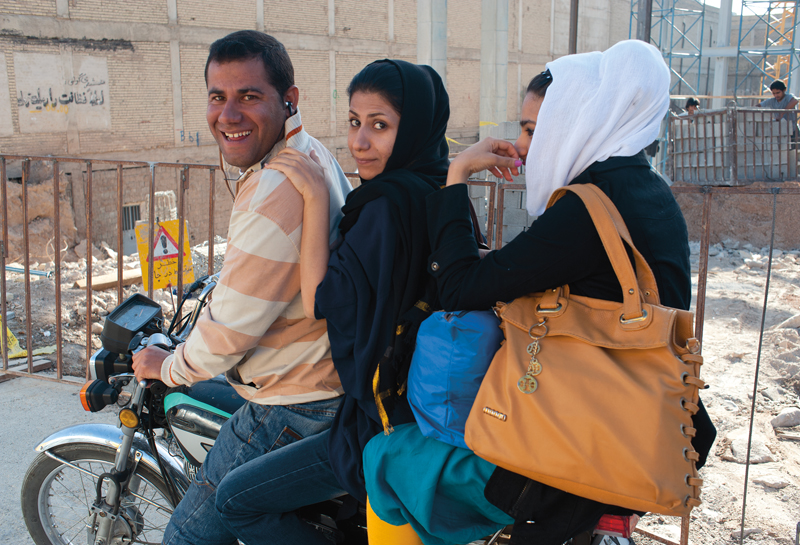
Shiraz, Iran—Motorcycle trio near the shrine of Shah Chirag (see Mirrors and Patterned Light).
Iran is known as Persia in many books and writings (the country’s name was changed to Iran in 1935), and that is the term I use more often in this book. It’s a country of about eighty million people living in a territory about half the size of India. At the moment, the country is a theocracy, ruled by the head of the Twelver sect of Shia Islam, as well as by an elected parliament.
Geographically, Iran is a kind of keystone in West Asia. It’s not Arab, not Turkic, not South Asian, not European. It lies between the predominantly Arab and Turkish world of the Middle East and the countries of central Asia and the Indian subcontinent. In the nineteenth and early twentieth centuries, the Russians and British sought to control it because of its strategic location and its oil.
Over its long history, Persia has often been a powerhouse, the center of an empire that conquered not just the Caucasus countries but also huge swaths of central Asia and the Middle East. As a result, it has had a huge cultural and culinary influence not just on its neighbors but also on Europe, North Africa, and India and Pakistan.
The majority population in Iran is Persian and speaks Persian (also called Farsi). There are also peoples of other cultures and ethnicities, including ethnic Azeris, Armenians, Georgians, Kurds, Assyrians, and Arabs. They are minority peoples in a country dominated by the descendants of Darius the Great and Xerxes.
Persians are proud of their cuisine, which is famous for its rice dishes, its subtle and seductive soups known as ash, the artful use of pomegranate molasses as a flavoring in dishes such as fesanjun, and its varied kebab repertoire. There’s much more to discover, a world of home-cooked dishes that have both freshness and depth of flavor, with an inspired use of mint (both fresh and dried), dill, tart barberries, saffron, and the dried limes known in Iran as limoo omani, and a lovely balancing of flavors. Among my favorite dishes are Persian borani, lightly cooked vegetables dressed with thick yogurt and topped with fried onions (see recipes here and here); all of the greens-and-beans-laden soups; and the sophisticated sweets.
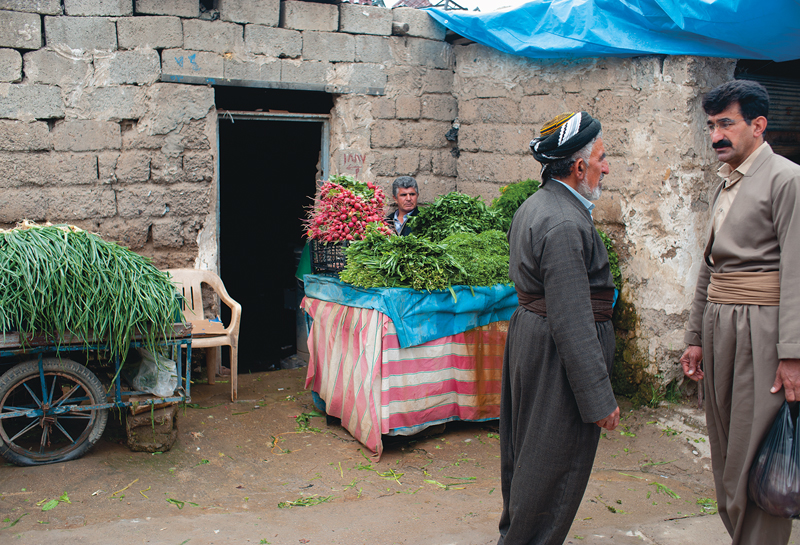
Halabja, Kurdistan—Two Kurdish men wearing traditional clothing chat in the market.
Kurdistan is a small oil-rich region in northeastern Iraq, with an area a little smaller than that of Switzerland. It has a long border with Iran and also borders southeastern Turkey. Although the majority Kurdish population is Sunni Muslim and fairly conservative, modern Kurdistan is determinedly secular and officially tolerant of other religions. The Kurdish languages (three distinct Kurdish languages are spoken in Kurdistan) are all related to Persian, and the people of Kurdistan have close links with Iran. There is active trade (both legal and illegal) across the border, and in the 1970s and ’80s, many Kurds took refuge in Iran from Saddam Hussein’s attacks.
Iraqi Kurdistan is ridged with a series of hills and valleys that run north to south. Part of Kurdistan lies in the valley of the Tigris River, an area that was at the center of the Assyrian Empire until it was conquered by the Persians about 2,600 years ago. Some Assyrians still live here, in small villages as well as in and around the capital, Arbil. The Yazidis, much persecuted over the centuries, are another distinct minority group in Kurdistan.
The Kurds grow wheat and short-grain rice, as well as fruits, vegetables, and nuts. Flatbreads are part of every meal, and rice is eaten twice a day in most households. Traditional Kurdish rice dishes are more like Mediterranean dishes such as risotto, and very unlike Persian rice. Herbs are served as part of the meal and also used (usually dried) as a seasoning. Like the Persians, Kurdish cooks include dried limes, the aromatic limes that they call limoo basrahi, in some of their stews. Glasses of liberally sugared tea punctuate the day, both at home and in public places.
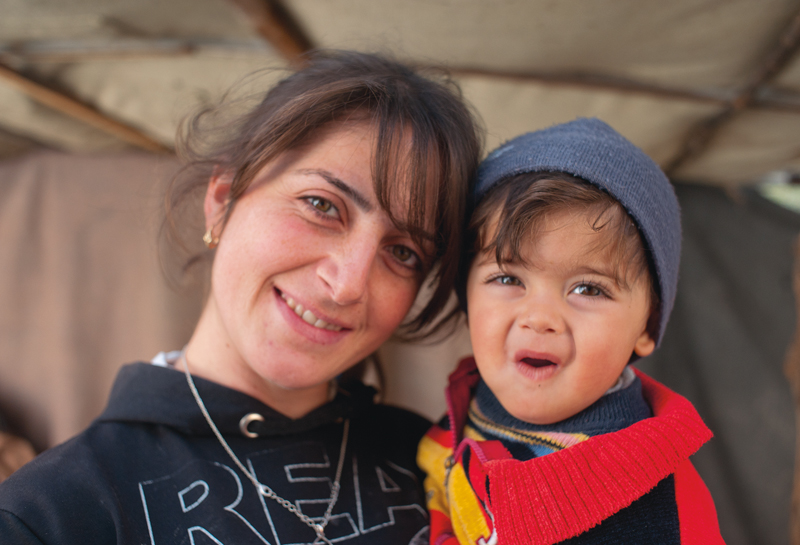
Tatev, Armenia—A young mother and child were part of a family that invited me to join them as they snacked and drank tutovka.
Like Georgia and Azerbaijan, Armenia was a Soviet republic until the USSR split up in the early 1990s. The newly independent country of Armenia (Hayastan in Armenian) has a long and fascinating history. The early people of Armenia made wine and cultivated wheat and barley, and they left a treasure of early metalwork and other artifacts dating back to prehistoric times. Armenian is an Indo-European language that has had its own alphabet since the fifth century, when the country converted to Christianity from Zoroastrianism.
The smallest of the Caucasus countries, with a population of about three million, Armenia today is a remnant of what was once Greater Armenia, a kingdom whose territory extended across much of eastern and southern Turkey to the Mediterranean. That territory was at times controlled by the Persian Empire and eventually conquered by the Ottomans who ruled Turkey. Tens of thousands of Armenians living under Ottoman rule died during the genocide that began in 1915; the survivors fled the country. The Armenian diaspora includes large populations in North America, and there are also Armenians still living in Iran, Syria, and Lebanon.
The tough climate and the intermittently hard times Armenia has suffered have resulted in a remarkably creative cuisine, anchored by the need for frugality and self-sufficiency. The foods of present-day Armenia are quite unlike those of the western Armenians, who until the genocide had lived for centuries in what is now Turkey, and in Syria. Sunflower is the main oil rather than the olive oil of western Armenian cuisine, and is at the heart of everyday dishes based on vegetables, dried beans, and whole grains, subtly flavored with tart fruits and herbs. Because of the fasting traditions of the Armenian church, there’s a large repertoire of delectable meatless dishes, such as Cabbage Rolls Stuffed with Beans and Tart Fruit (see recipe), a boon for vegetarians.
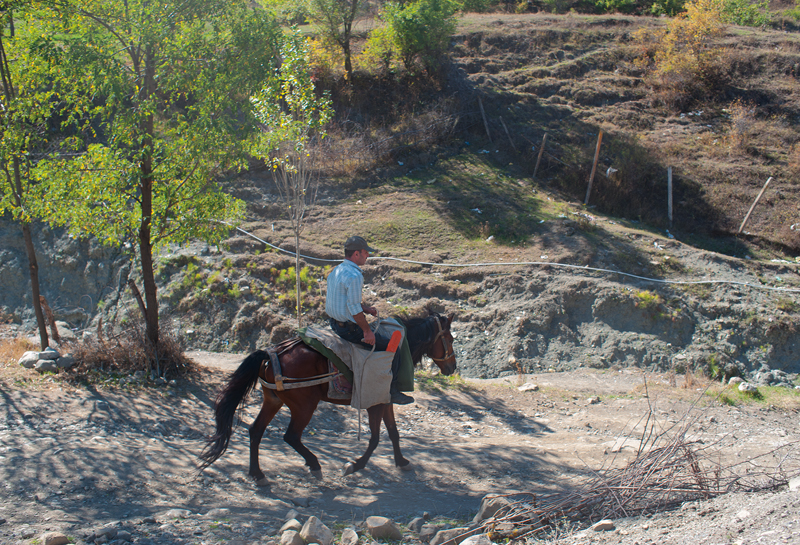
Lahich, Azerbaijan—A horseman rides along a rocky streambed at the edge of the village.
Azerbaijan is an oil-rich country about the size of Austria, with a population of roughly nine and a half million. It’s bordered by the steep snowcapped Caucasus Mountains to the north, which define its frontier with Russia. South of the mountains the terrain is mostly fertile low-lying valleys. To the northwest is the Republic of Georgia, while to the east, Azerbaijan has a long coast on the Caspian Sea.
Today more Azeris live in neighboring Iran (where they constitute about 16 percent of the Iranian population) than in Azerbaijan. The whole Azeri-inhabited territory was ruled by Persia for many centuries, but it was divided between the USSR and Iran after a brief moment of independence from 1917 to 1920. Since the breakup of the Soviet Union, the former Soviet Azerbaijan has established itself as an independent country. Though most Azeris are Shia Muslim, Azerbaijan, which is ruled by an authoritarian regime, is determinedly secular. Azeri, a Turkic language that is laced with words of Persian origin, is the mother tongue of most people in Azerbaijan, many of whom also speak (and read) Russian.
As in Georgia, walnuts, pomegranates, grapes, plums, and sour plums are important ingredients. Azeri home cooks, like those in Georgia and Armenia, put up a gorgeous array of fruit juices and morabas (jams; see Apricot Moraba). Fresh cheese is part of most meals. There’s also a tradition of filled dumplings and dolmas (stuffed vegetables). And, as you might expect with a Turkic culture, grilled meat, poultry, and fish are much loved (see Turkey Kebabs).
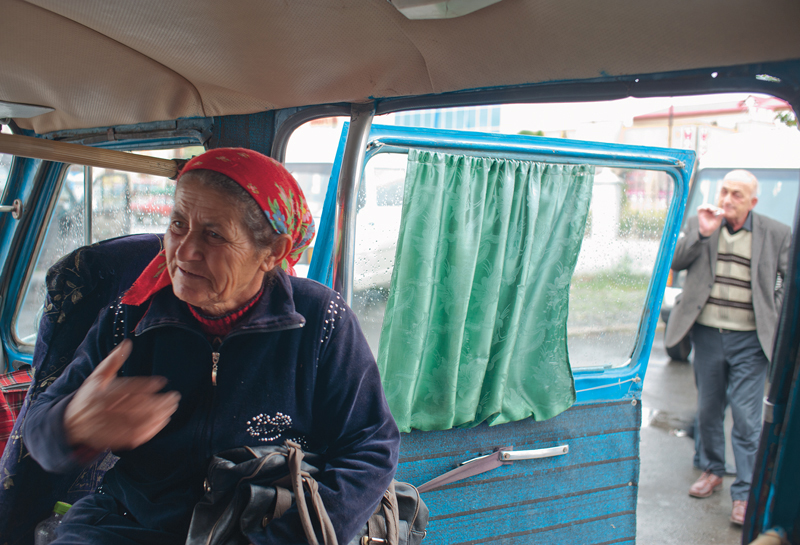
Zaqatala, Azerbaijan—Public transport in rural Azerbaijan is mostly in tired, though charming, vans. Here, not far from the Georgian border, we stopped for a few more passengers.
A small country about the size of the Republic of Ireland, Georgia has a dramatically varied landscape, and a current population of less than four million. Like Armenia and Azerbaijan, Georgia was under Persian rule intermittently for centuries. But starting early in the nineteenth century, Russia fought Persia for the Caucasus countries, and it finally took complete control of them in 1828. Georgia had a moment of independence from 1918 to 1921, but then was forcibly incorporated into the USSR. When the Soviet Union broke up, Georgia regained its independence.
The early people of Georgia, like the Armenians and the early inhabitants of Azerbaijan, cultivated wheat, other grains, and legumes. These are still an important part of Georgian agriculture and cuisine, along with winemaking, fruit of all kinds, and shepherds’ cheeses. Georgians are famous for their cheese-filled breads, called khachapuri.
Perhaps the most distinctive element of Georgian cooking is its use of utskho suneli, blue fenugreek. Together with ground coriander, it is the basis of the spice blend known as kmeli suneli (see recipe), which varies according to the cook’s taste. There’s more raw garlic in Georgian cuisine than elsewhere in the region, and fresh tarragon and coriander (cilantro) play a big role, along with tart fruits and walnuts. Among my favorite Georgian dishes are the walnut-based vegetable pâtés called pkhali (see recipe) and the tart fruit sauces, such as tkemali (Sour Plum Sauce).